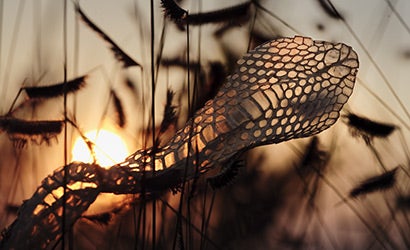The Last Real American Landscape
Photographer Jim Richardson savors a place of quiet beauty in his own back yard.

Compared to the soaring peaks of the Rocky Mountains, or the curving sensuality of the California coast, the Flint Hills of Kansas wouldn’t seem to have much to offer a photographer. Jim Richardson doesn’t see it that way, though that may be because he was born and raised in Kansas and lives there now, in the town of Lindsborg, about 50 miles from the Flint Hills.
A longtime National Geographic photographer, Richardson looks on the Flint Hills as a great American landscape, and the last of its kind. Once, a great belt of tall grass prairie covered the country’s entire heartland. Now, the Flint Hills area is about all that is left.
“It represents about four percent of all the prairie we once had,” says Richardson. “This section was saved because it was in ranching, and it was in ranching because it was too hard to plow. Eons ago this was the bottom of the Permian Sea, and layers of rock were laid down flat as they eroded out of the Rocky Mountains.”
Richardson’s work has taken him all over the world — in recent years he’s done stories on the Celtic heritage of Brittany and the whiskey lands of Scotland — but he often found time to shoot in the Flint Hills. He confesses, however, that he never had much luck there.
“The prairie is difficult to photograph,” he says. “These are low, rolling hills, and every time you pick up a camera and point it at them, they kind of get small in the distance. They aren’t like the Tetons, which are big enough to fill a 4×5 frame.”
Nonetheless, two years ago Richardson proposed a story on the Flint Hills to National Geographic, and to his surprise the magazine said yes. “I think it helped that the editor in chief, Chris Johns, used to work with me at the Topeka Capital-Journal,” he says.
| © Jim Richardson/National Geographic |
The challenge to Richardson was to capture in photographs the beauty he saw in the area. “They have this lovely maternal look to them, in the grace of the curves, the rifts in the valleys and all,” he says. He approached the assignment as he does all his other Geographic work. “You drive a hell of a lot of miles to find the places that have the look you want. You go out at every time of day, in every kind of weather, and if you can to hire a plane and shoot from above. You basically work the story for all it’s worth.”
Richardson shot the entire project with a Canon EOS 5D digital SLR. The choice to shoot digitally allowed him to make a photo that would become one of the story’s signature images. “I read somewhere that because of city lights about 80 percent of the world’s population cannot see the Milky Way any longer, but that is not a problem in the Flint Hills,” he says. “I was lucky to be shooting digitally, because there is no film fast enough with a high enough quality to get that shot.” In the picture, a small tree on a low ridge is visible in the foreground. “I lit the tree with a small Maglite flashlight, then exposed the entire shot for 30 seconds at f/1.4 at ISO 1600,” he says.
The story, which appeared in the April 2007 issue of National Geographic, followed the Flint Hills through it annual cycles — from early March, when prairie chickens start their courting rituals, or “booming,” through the burn season, when local ranchers burn off the dead, dry grass of the area to keep other species of vegetation from taking root. “That’s basically a man-made version of what happened naturally on the prairie,” says Richardson. He then shot the regrow period, when new grass turn the hills an emerald green.
Prior to the article’s publication, Richardson arranged with the magazine to allow the images to be printed and shown in small towns in Kansas. “I think we Kansans have an inferiority complex” he says. “This show was to say, look, this is a great resource we have here, and we need to cherish it, value it, and protect it.” The traveling exhibition has proved popular: It is now booked in various Kansas towns through 2009.
Richardson is one of several environmentally conscious photographers to be featured in American Photo’s first-ever Green Issue, available in September.

The-Last-Real-American-LandscapeDuring-the-burn-se

The-Last-Real-American-Landscape

The-Last-Real-American-Landscape

The-Last-Real-American-Landscape

The-Last-Real-American-Landscape

The-Last-Real-American-Landscape

The-Last-Real-American-Landscape

The-Last-Real-American-Landscape

The-Last-Real-American-Landscape

The-Last-Real-American-Landscape

The-Last-Real-American-Landscape